MBBS/BDS Entrance Exam Curriculum by MOE (Nepal)
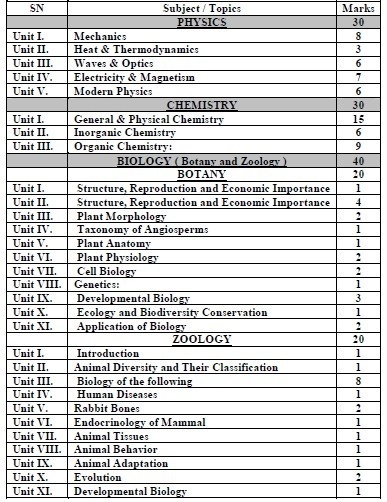

PHYSICS
Group (A) Mechanics
- General concept of physical quantities, Vector algebra
- Laws of Motion, Application of Newton’s laws, Work, Energy and Power, Projectile motion
- Circular Motion, Motion round a banked track and in vertical circle
- Newton’s law of gravitation, Variation of ‘g’ with altitude and depth, Satellites, Gravitational potential energy, Escape velocity, Black holes
- Elasticity, Hooke’s law, Young modulus, Bulk modulus, Elastic potential energy
- Oscillatory motion, Simple harmonic motions, Damped oscillation, Forced oscillation and resonance
Group (B) Heat and Thermodynamics
- Concept of heat and temperature, Expansion of solid and liquid, Specific heat capacity, specific heat capacity of solid, Specific latent heat of fusion and its measurements
- Thermal conductivity and its determination by Searle’s method, Black body radiation, Stefan-Boltzmann law
- Thermodynamic systems, First law of thermodynamics, Heat capacities of ideal gas at constant pressure and constant volume and relation between them, Isothermal and adiabatic processes for an ideal gas, Second law of thermodynamics
Group (C) Waves and Optics
- Reflection & Refraction of light, Refractive index, Lateral shift, Minimum deviation through prism, Relation between angle of prism, minimum deviation and refractive index, Lenses, Combination of thin lenses in contact
- Dispersion, Dispersive power, Achromatic lenses, Scattering of light, blue color of the sky
- Optical instruments, Angular magnification, Compound microscope, Astronomical Telescope
- Longitudinal and transverse waves, Progressive and stationary waves, Velocity of sound in medium, Laplace’s correction, Stationary waves in closed and open pipes, Harmonics and overtones in closed and open organ pipes, Resonance tube experiment, Laws of transverse vibration of a stretched string
- Characteristics of sound, Intensity, loudness, quality and pitch, Beats, Doppler’s effect, Infrasonic and ultrasonic waves
- Physical optics, Wave theory of light, Interference, Diffraction and Polarization, Coherent sources, Young’s double slit experiment, Diffraction grating, Brewster’s law
Group (D) Electricity and Magnetism
- Coulomb’s law – Force due to point charges, Gauss law and its applications: Field of a charged sphere, Line charge; Potential due to a point charge, Electron volt, Capacitance of a capacitor, Parallel plate capacitor, Combination of capacitors
- Electric Currents, Drift velocity and its relation with current, Ohmic and Non-Ohmic resistance, Resistances in series and parallel, Electromotive force of a source, Internal resistance, Work and power in electrical circuits, Kirchhoff’s laws, Wheatstone Bridge circuit, Meter Bridge, Potentiometer
- Magnetic field lines and magnetic flux, Force on moving charge, Force on conductor, Force and torque on rectangular coil, Ampere’s law and its application to i) a long straight conductor ii) a straight solenoid, Faraday’s laws of electromagnetic induction, Lenz’s law
- AC through resistor, capacitor and inductor, Series circuits containing combination of resistor, capacitor and inductor, Series resonance, Choke coil
Group (E) Modern Physics
- Electrons: Millikan’s oil drop experiment, Cathode rays and their properties; Motion of electron beam in electric and magnetic fields, Thomson’s experiment to determine specific charge of electrons
- Quantum nature of radiation, Einstein’s photoelectric equation, Stopping potential
- Intrinsic and extrinsic semi-conductors, P-N Junction diode, Forward and reverse bias, Rectification, Zener diode
- Bohr’s theory of hydrogen atom, Spectral series, Excitation and ionization potentials, Energy level, de Broglie Theory, Duality, Uncertainly principle
- Lasers: Properties and uses, X-rays: Production, properties and uses
- Basic concepts of nucleus, Mass Defect and amu, Einstein’s mass-energy relation, Binding energy, Fission and fusion, Alpha-particles, Beta-particles, Gamma rays, Laws of radioactive disintegration, Half-life and decay constant, Health hazards and safety precautions
CHEMISTRY
Group (A) GENERAL AND PHYSICAL CHEMISTRY
Part (1) Language of Chemistry and Chemical Arithmetic
I. Language of Chemistry (Review)
- Chemical equations, their significances and limitations.
- Balancing chemical equations by: Hit and trail method and Partial equation method
- Types of chemical reaction
- Chemical Arithmetic
- Dalton’s atomic theory and Laws of Stoichemistry: Postulates of Dalton’s atomic theory, Law of conservation of mass, Law of constant proportions, Law of multiple proportion, Law of reciprocal proportion, Law of gaseous volumes, Chemical calculations based on stoichiometry
- Atomic Mass and Molecular Mass:
- Definition of atomic mass and molecular mass
- Mole concept
- Mole in term of mass, volume number and ions
- Calculation based on mole concept
- Empirical, Molecular Formula and Limiting Reactants:
- Percentage compositions
- Derivation of empirical and molecular formula from percentage composition
- Chemical calculation based on following chemical equation
- Limiting reactants
- Mass-mass relationship
- Volume- volume relationship
- Mass volume relationship
- (Solving related numerical problems)
- Avogadro’s Hypothesis and its applications:
- Development of Avogadro’s hypothesis
- Definition of Avogadro’s hypothesis
- Application of Avogadro’s hypothesis
- Deduction of atomicity of elementary gas
- Deduction of relationship between molecular mass and vapour density
- Deduction of molar volume of gases
- Deduction of molecular formula from its volumetric composition
- (Solving related numerical problems)
- Equivalent Masses:
- Concept of equivalent mass
- Equivalent weight of elements and compounds (Salt, acid, base, oxidizing agents, reducing agents)
- Gram equivalent weight (GEW)
- Relation between equivalent weight, valency and atomic weight
- Determination of equivalent weight of metal by
- Hydrogen displacement method
- Oxide formation method
- (Solving related numerical problems)
Part (2) States of Matter
I. Gaseous State:
- Boyle’s law
- Charles law and Kelvin scale of temperature
- Application of Charles law and Boyle’s law
- Combined gas law, ideal gas equation and universal gas constant
- Dalton’s law of partial pressure
- Mathematical derivation of Dalton’s law and their applications
- Graham’s law of diffusion and its applications
- Kinetic model of gas and its postulates
- Ideal and real gases
- Deviation of gas from ideal behavior
- (Solving related numerical problems)
II. Liquid State:
- Physical properties of liquid
- Evaporation and condensation
- Vapour pressure of liquid and boiling
- Surface tension
- Viscosity
- Solution and solubility:
- Equilibrium in saturated solution
- Solubility and solubility curve and its applications.
- (Solving related numerical problems)
III. Solid State:
- Crystalline and amorphous solids
- Water of crystallization
- Efflorescence
- Deliquesces
- Hygroscopic
- Seven types of crystal system
- Simple cubic, face centered and body centered
Part (3) Atomic structure and Electronic theory of valency
- Discovery of fundamental particles of atom (electron, proton and neutron)
- Concept of atomic number, mass number, fractional atomic mass, isotopes, isobars
- Rutherford’s α ray scattering experiment and nuclear model of atom; limitation
- Bohr’s model of atom and explanation of hydrogen spectra
- Limitation of Bohr’s model of atom
- Elementary idea of quantum mechanical model
- Dual nature of electron (de-Broglie equation)
- Heisenberg’s uncertainty principle
- Probability concept
- Shape of atomic orbital (s and p orbitals only)
- Quantum numbers
- Pauli’s exclustion principle
- Hund’s rule of maximum multiplicity
- Aufbau principle and Bohr Bury rule
- Electronic configuration of the atoms and ions (Z= 1 to 30)
- Basic assumption of electronic theory of valency
- Octet rule
- Ionic bonds, ionic compounds and characteristics of ionic compounds. Lewis symbol to represent the formation of ionic compounds
- Covalent bonds, covalent compounds and characteristics of covalent compounds-Lewis structure of some typical covalent compounds
- Co-ordinate covalent bonds. Lewis structures of some typical co-ordinate covalent compounds
- Exception of the octet rule
- Partial ionic characters of covalent compounds. Non-polar and polar covalent molecules
Part (4) Periodic Classification of Elements
- Introduction
- Mendeleev’s periodic law and periodic table
- Anamolies of Mendeleev’s periodic table
- Modern periodic law, and modern periodic table
- Advantage of modern periodic table
- Division of physical properties: valency, atomic radii, ionic radii ionization energy, electron affinity and electronegativity (general trends only)
Part (5) Oxidation and Reduction
- Classical concept of oxidation and reduction
- Electronic interpretation of oxidation and reduction
- Oxidation number and rules for the assignment of oxidation number
- Differentiate between oxidation number and valency
- Oxidising and reducing agent
- Redox reaction
- Balance redox reactions by:
Oxidation number method
Ion-eletron method
Group (B) INORGANIC CHEMISTRY
Part (1) Non-metals
- Water
- Structure
- Solvent property of water
- Heavy water and uses
- Uses
- Nitrogen and Its compounds
- Ammonia
- Manufacture by Haber’s synthesis method
- Physical properties, chemical properties and uses
- Carbon
- Allotropes of carbon including fullerenes
- Sulphur
- Hydrogen Sulphide: (Laboratory methods and Kipp’s apparatus), properties and uses of
- Sulphurdioxide: Laboratory preparation, preparation and uses
- Sulphuric acid: Manufacture by contact process, properties and uses
- Environmental Pollution:
- Air pollution, photochemical smog
- Acid rain, water pollution
- Green house effect
- Characteristics of metals, non-metals and metalloids
- Minerals and ores
- Important minerals deposit in Nepal
- Different process involved in metallurgical process
- Concentration
- Calcinations and roasting
- Smelting
- Carbon reduction process
- Thermite process
- Electrochemical reduction
- Refining of metals: poling, electro-refinement etc.
Part (2) Metal and Metallurgical Principles
Group (C) ORGANIC CHEMISTRY
Part (1) Introduction ot Organic Chemistry
I. Fundamental Principles:
- Definition of organic chemistry and organic compounds
- Origin of organic compounds (vital force theory)
- Reasons for the separate study of organic compounds
- Tetra covalency and catenation property of carbon
- Classification of organic compounds
- Functional groups and homologous series
- Meanings of empirical formula, molecular formula, structural formula and contracted formula
- Qualitative analysis of organic compounds. (detection of N, S and halogens by Lassaegne’s test)
II. Nomenclature of Organic Compounds
- Common names
- IUPAC system and IUPAC rules of naming hydrocarbons, alcohols, ethers, aldehydes, carboxylic acid, amines, ester, acid derivative halogen derivatives, nitriles etc.)
III. Structure Isomerism in Organic Compounds
- Definition of structure isomerism
- Types of structure isomerism: chain isomerism, position, isomerism, functional isomerism and metamerism
IV. Preliminary Idea of Reaction Mechanism
- Concept of hemolytic and heterolytic fission
- Electrophile, nucleophiles and free-radicals
- Inductive effect, +I and –I effect
- Hybridization and concept of sigma and pi bond
- Valence shell Electron Pair Repulsion (VSEPR) theory
- Prediction of molecular geometry (Shape of molecules) on the basis of VSEPR and hybridization.(BeF2, BF3, NH3, H2O, CH4, H2O, C2H2 C2H4 H2S)
Part (2) Chemical Bonding and Shape of Molecules
Part (3) Volumetric Analysis
- Different ways of expressing the concentration of solutions.
- Molarity
- Normality
- Molality
- Gram/ Litre
- Percentage
- Titration:
- Acid-base titration
- Redox titration
- Primary standard substances, primary standard solution, secondary standard solution, end point, equivalence point, neutral point, indicators.
- Derivation of normality equation
- Relation between normality and molarity
- Selection of indicators in acid-base titration and PH curve
- Solving related numerical problems
Part (4) Ionic Equilibrium
- Introduction
- Ionization of weak electrolyte (Ostwald’s dilution law)
- Degree of ionization and ionization constant
- Strength of acid and base in term of Ka, Kb and pKa, pKb values
- Acid-base concept
- Arrhenius concept of acids and bases
- Bronsted lowrry concept concept of acids and bases
- Lewis concept of acids and bases.
- Ionization of water, pH and pH scale.
- Hydrolysis of salts. (qualitative concept)
- Solubility product principle and its application
- Common ion effects and its application
- Application of solubility product principle in qualitative analysis
- Buffer Solution
- (Solving numerical problems related with solubility, solubility product, pH and pOH)
Part (5) Alcohols and Phenols
I. Alcohols
- i. Introduction, classification, nomenclature and isomerism
- ii. Distinction of primary, secondary and tertiary alcohol by Victor Mayer’s Method
- iii. Preparation of monohydric alcohols form
- Haloalkane
- Grignard’s reagents using aldehydes
- Primary amines
- Ester
iv. Industrial preparation ethanol form:
- Oxoprocess
- Fermentation of sugar
- Hydroboration of ethane
- Physical properties monohydric alcohols
vi. Chemical properties of monohydric alcohols
- Reaction with HX. PX3, PCl5SOCl2
- Action with reactive metals like Na, K, Li
- Esterification process
- Dehydration of alcohols
- Oxidation of primary, secondary and tertiary alcohol with oxidizing agents.
- Reduction of alcohols (Catalytic dehydrogenation)
- Laboratory test of ethanol
- Absolute alcohol, methylated spirit, rectified spirit; alcoholic beverage.
- Preparation and uses of ethan- 1.2. diol (glycol)
- Peparation and uses of Propan- 1, 2, 3 triol (glycerol)
II. Phenols
- Introduction to phenol
ii. Preparation of phenol from
- Chlorobenzene
- Diazonium salt and
- Benzene sulphonic acid
- Physical properties of phenol
- Chemical properties
- Acidic nature of phenol
- Action with PCl5, PX5, NH3, Zn, Na benzene diazonium chloride and phthalic anhydride
- Acylation reaction, Kolbe’s reaction, Reimer Tiemann’s reaction
- Electrophilic substitution: halogenations, nitration, sulphonation bromination and Friedal Craft’s alkylation
- Laboratory test of phenol
- Uses of phenol
Part (6) Aldehydes and Ketones
I. Aliphatic Aldehydes and Ketones
- Introduction, structure of carbonyl group, nomenclature and isomerism in carbonyl compound
ii. Preparation of aldehydes and ketones from
- Dehydrogenation and oxidation of alcohol
- Ozonolysis of alkenes
- Acid chloride
- Gem dihaloalkane
- Catalytic distillation of fatty acid
- Distillation of salt of fatty acid
- Catalytic hydration of alkynes
iii. Physical properties
iv. Chemical properties
- Addition reaction: addition of H2, HCN, NaHSO3 and Grignard’s reagents
- Action with ammonia derivatives; NH2OH, NH2- NH2, phenyl hydrazine, semicarbazides and 2,4-DNP
- Reduction properties of aldehydes
- Oxidation with Tollen’s reagent, Fehling’s solution
- Aldol of condensation reaction; clemennson’s reduction Wolf-Kischner reduction, Action with PCl5, action with ammonia, action with phenol, formalin and its uses.
II.Aromatic Aldehydes and Ketones
- Preparation of benzaldehyde from toluene
ii. Properties of benzaldehyde
iii. Important reaction benzaldehyde different from aliphatic aldehydes:
- Perkin condensation
- Benzoin condensation
- Electrophilic substitution reaction
- Canninzaro’s reaction
- Preparation of acetophenone by Friedal Craft’s acylation
Part (7) Molecules of Life
- Carbohydrates: definition, classification of carbohydrates, various examples of carbohydrate of different class. Structure and glucose and fructose, function of carbohydrates, sugar and non-sugar.
- Protein: definition, amino acid, essential and non-essential aminoacids, peptide linkage, hydrolysis of aminoacids, denaturation of protein, zwitter ions, functions of aminoacids.
- Nucleic acid: definition, basic components of nucleic acid; double helix, difference between RNA and DNA; biological function of nucleic acid
- Lipid: definition, fatty acids, fat as ester of fatty acid and difference between fats and oils, function of lipid
- Enzymes and their functions.
Part (8) Chemistry in Service to Mankind
- Polymer: definition, natural and synthetic polymers, homopolymers and co-polymer preparation of some polymers; PVC polyethene polystyreno Teflon, Nylon-66, Bakelite and their uses
- Dyes and drugs : definition, natural and synthetic dyes, names and structure of some common drug, drug addiction
- Fertilizer: definition, chemical and organic fertilizers, nitrogen fertilizer, phosphatic fertilizer; fertilizer as pollution
- Pesticides: insecticides, herbicides, weedicides and fungicides (examples and their uses).
BIOLOGY
Group (A) BOTANY
Part (1) Introduction to biology
- Scope of biology, field of bilogy, life processes
- Biomolecules (macromolecules & micromolecules)
- Taxonomy
- Two kingdom and five kingdom system of classification
- Binomial/trinomial nomenclature
- Structure, types and economic importance of virus, bacteria and lichens
Part (2) Biodiversity
- Structure and life cycle of Spirogyra, Blue green algae, Marchantia, Dryopteris, Cycas and Pinus
- Floral diversity of Nepal
- Forest conservation
- Types of forest of Nepal & their management
Part (3) Morphology
- Distributation, habitat, habit, root, stem, leaf, flower, fruit and seeds of families – Brassicaceae, Solanaceae, Papilionoidae, Asteraceae and Poaceae
- Taxonomy and economic importance of families given above
Part (4) Cytogenetics
- Cytology
- Introduction, structure and functions of prokaryotic and eukarotic cells
- Cell division – amitosis, mitosis and meiosis
- Genetics
- Introduction, Mendelism, Genetic material ( DNA & RNA), Mutation
Part (5) Anatomy and physiology
- Anatomy
- Types of tissues (meristematic, permanent and special types of tissues)
- Internal structure of dicot and monocot leaf, stem and root
- Physiology
- Water relation – osmois, diffusion, anscent of sap and transpiration
- Photosynthesis – mechanism and factors
- Respiration – anaerobic and aerobic
- Hormones – physilolgical effects of auxins, gibberllin, cytokinin and abscisic acid
Part (6) Ecology
- Introduction, ecosystem (pond & grassland)
- Biogeochemical cycle – nitrogen and carbon
- Ecological imbalance and its consequences – green house effects, acid rain , depletion of ozone layer
Part (7) Developmental biology
- Reproduction – vegetative propogation, sporogenesis, gametogenisis
- Pollination, fertilization
Part (8) Application of biology
- Introduction to biotechnology, tissue culture, concept of breeding technique, disease resistant plants, biofertilizer, perticides
- Genetic engineering and its application
- Fermentation technology – alcoholic, antibiotics, organic acids
Group (B) ZOOLOGY
Part (1) Biodiversity
- Kingdom – Protista – general characters and classification of phylum – Protozoa upto classes with eamples
- Paramecium caudatum – distributation, habitat, habit, structure and reproduction
- Kingdom – Animalia – general characters and classification of phyla – Porifera, Cnidaria, Platyhelminthes, Nemathelminthes Annelida, Arthropoda, Mollusca, Echinodermata and Chordata upto clases with examples.
- Faunal diversity of Nepal
Part (2) Anatomy and type study
- Animal tissues – epithelial, connective, muscular and nervous, their structure, types, location and function
- Earthworm and forg – distrubutation, habitat, habit, external feature, digestive system, respiratory system, excretory system, circulatory system, nervous system, reproductive system and economic importance.
Part (3) Human/rabbit physiology
- Digestive system – alimentary canal, associated glands and physiology of digestion
- Respiratory system – lungs, mechanism of breathing, physiology of respiration
- Escretory system – kidney, urine formation, osmoregulation and homoeostaisis
- Circulatory system – heart, working of heart, blood groups, blood prssure, arterial and venous system
- Reproductive system – male and female reproductive orgnas, associated glands, memtrual cycle.
- Nervous system – CNS (Brain and spinal cord), PNS and ANS
- Endocrine system – pituitary gland, thyroid gland, parathyroid gland, pancreas
Part (4) Developmental biology
- Gametogenesis – spermatogeneris, oogeneris
- Fertilization, cleavage
- Morulation, blastucation, gastrulation and neurulation
- Coelom formation
- Fate of three primary germinal layers
Part (5) Origin and evolution
- Evolution – inorganic, organic
- Inorganic evolution – originof life, Oparin – Haldane’s theory, Miller – Urey experiment
- Organic evolution – evidences of organic evolution
- Lamarchism, Darwinism, Neo-Darwinism
- Human evolution
Part (6) Environmental relations
- Environmental pollution – air and water, sources, effects and control measures
- Migratory behavior of fishes and birds
- Adaptation in amimals – aquatic terrestrial, aerial
- Conservaton of wild life, wild life reserves, national parks, natural resources
- Protection of the earth – human responsibility
- Human population growth – consequences of over population, control measures
Part (7) Diseases
- Smoking, alcoholism, drug abuse, symptoms impact on health and society, rehabilitation, control
- Malaria, ascariaris, typhoid, tuberculosis, HIV/AIDS, mode of trammission, symptoms, control
- Cancer – types, symptoms, control
Part (8) Medical technology and economic zoology
- Test tube baby
- Amniocentesis
- Tissue and organ transplantation – skin, cornea, kidney, blood transfussion
- Animal breeding
- Fish farming, poultry farming
- Antibiotics and vaccines
Marking Scheme:


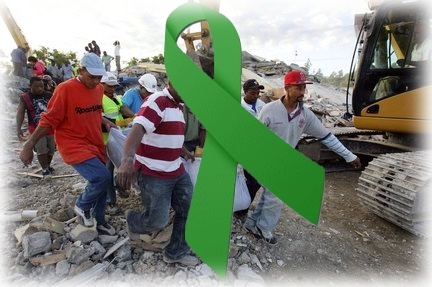
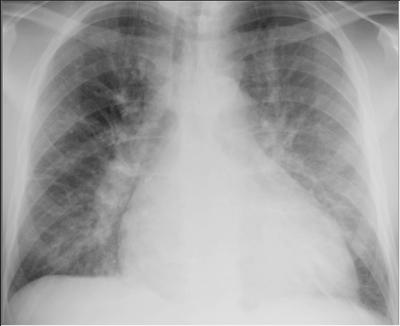
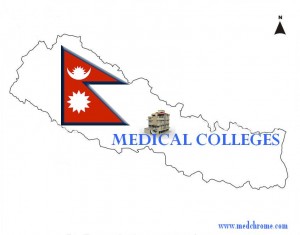
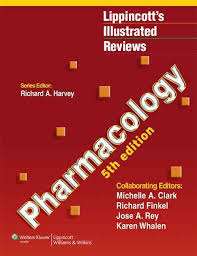
64 Comments
being a brahamin the poor person is deprived of qUOTAS
to get moe SCholarship But the madhesis who study in ktm get quotA TO STUDY WHAT A UNJUSTICS TO THE PERSON WHAT KIND OF GOVERNMENT IS THIS????????
sir, how many quotas r there 4 bistapit n having slc from public school
Sorry Kishor, but you need to get updated list form MOE website or from the MOE.
dear sir if we had got 48 in moe but we didnt get passed in iom then ……will moe will give us a letter to read in tu affiliated colz????…bcoz last time when we had went moe then administrator had told that we are eligible to read in tu affiliated colz….sir plz reply me fast…
i m janajati and disable too.so do i have more chance to get quota than the students who r janajati only?
Hello sir , may i know how many seats are there for disable?
Being one of the competitiors in the race of MBBS scholarship examination,I,Manish Kharel is completely dissatisfied by the scholarship system of MBBS exam in Nepal.There is the domination of sympathy over the ability of the candidates due to such system of scholarship. A student scoring 95 is not selected but on the other hand the one who scores just 70-75 and falls under the kota system is selected. If this continues then how can we hope for the better future in the medical field of our country?I had a dream of being a good doctor since childhood but my family’s economy doesn’t allow me to go for donation so I am also competing in this exam.Unfortunately,there is no kota system for me,so like me, many other brahmins and chhetries students are suffered a lot.Therefore i would like to request the concerned department to look and analyze my words once.Thank You!
Hello Manish,
Your comments are absolutely true. Free competition would be the best to select the deserving students. But it is also necessary that government provides opportunities to socially and economically deprived people, people in rural areas. So, the best alternative would be to provide opportunities in good colleges after schooling so that they can prepare for the future competitions like this one.
sir/mam i want full detailled information about muslim seats and madhesi seats.i hope i will get help.
Among 25% seat reservation for economically or socially deprived entrants:
Madhesi community: 20%
Muslim community: 2%
would u plz tell me that how many seats are reserved for madhesi(community school) this time(kartik 26).plz reply
20% seats have been reserved for Madhesi community.
sir,actually i am asking about the no.of seats(not percent).Hope for a quick reply.
Comments are closed.